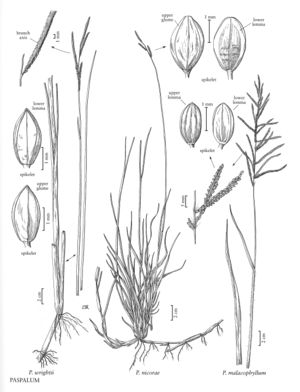Paspalum nicorae
Plants perennial; rhizomatous, rhizomes 5-25 cm, conspicuous. Culms 10-70 cm, erect to ascending; nodes glabrous. Sheaths glabrous, pubescent apically; ligules 1.2-1.5 mm; blades 6-20 cm long, 4-5 mm wide, flat to conduplicate, glabrous or pubescent. Panicles terminal, with 2-5 racemosely arranged branches; branches 1.4-5.2 cm, divergent; branch axes about 0.8 mm wide, glabrous, terminating in a spikelet. Spikelets 2.3-2.7 mm long, 1.4-1.8 mm wide, paired, appressed to or divergent from the branch axes, elliptic, dark-brown. Lower glumes absent; upper glumes shortly pubescent, 5-veined, margins entire; lower lemmas transversely rugose at maturity, glabrous, 5-veined, margins entire; upper florets dark glossy brown. Caryopses about 1.8 mm long, 1.4 mm wide, ellipsoidal. 2n = 40.
Distribution
Fla., Ala., Ga.
Discussion
Paspalum nicorae is native to Brazil, Uruguay, and Argentina. It was introduced to the United States for use in pastures and as a cover crop in waterways. It is now established in the southeastern United States, growing as a weed in pastures, turf, and other disturbed areas.
Selected References
None.
Lower Taxa
"decumbent" is not a number.
